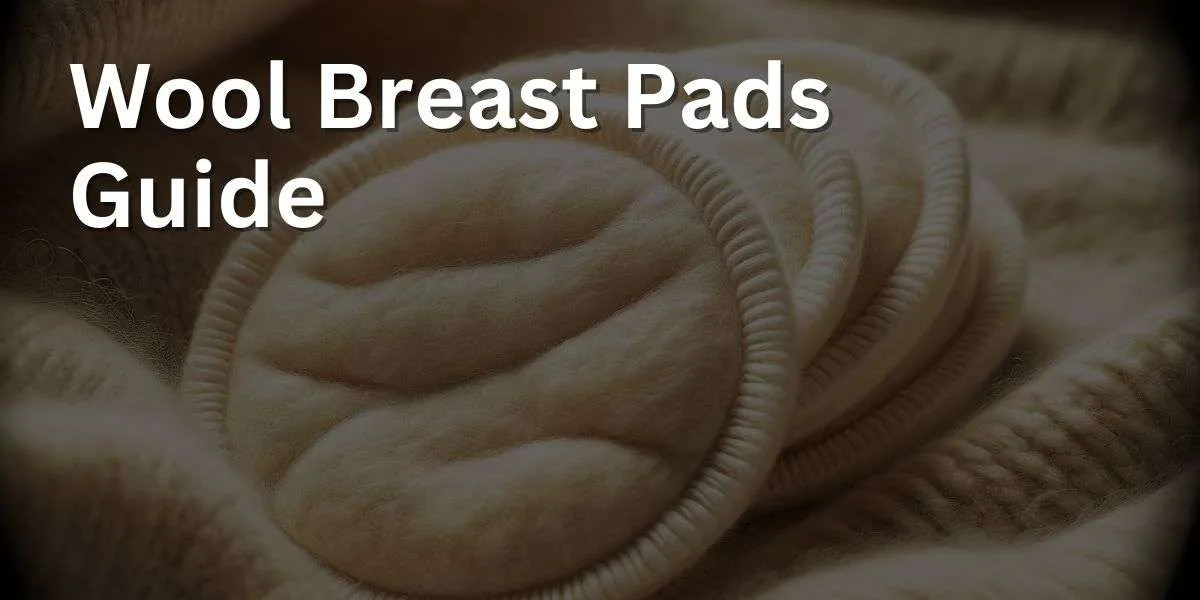Delving into the world of wool breast pads, this guide introduces nursing mothers to a natural and comfortable option for managing lactation.
We will explore the unique benefits of wool breast pads, including their breathability, natural moisture-wicking properties, and their ability to regulate temperature, making them a great choice for sensitive skin.
Learn how to select the right size, the proper way to use them, and essential care tips to keep these pads clean and effective.
Whether you’re a first-time mom or a seasoned parent, this guide will help you understand why wool breast pads might be an excellent choice for your breastfeeding needs.
Key Takeaways: Wool Breast Pads Guide
Natural and breathable material. Wool breast pads are made from natural wool fibers, offering excellent breathability and comfort.
High absorbency. Wool is highly absorbent, making these pads effective at managing leaks.
Temperature regulating. Wool naturally helps regulate temperature, keeping the breast area warm in cold weather and cool in hot weather.
Anti-microbial properties. Wool has natural anti-microbial properties, which can reduce the risk of odor and infection.
Gentle on sensitive skin. Wool pads are often well-tolerated by those with sensitive skin, though individual allergies or sensitivities to wool should be considered.
Care and washing. Wool pads require special care – they should be hand washed with a gentle wool detergent and air dried.
Lanolin replenishment. Over time, the lanolin in wool pads can diminish. Reapplying lanolin can help maintain their softness and antibacterial properties.
Durability. Wool pads are durable and can last a long time with proper care, making them a cost-effective choice in the long run.
Environmentally friendly. As a natural material, wool is a more environmentally friendly option compared to synthetic alternatives.
Understanding the Basics of Wool Breast Pads
Breast pads, also known as nursing pads, are an essential item for breastfeeding mothers. They provide a barrier between your nipple and your clothing, helping to prevent leaks and stains.
Breast pads come in various materials, each with its advantages and disadvantages. One of the popular choices is wool breast pads, which offer a natural and sustainable option.
Wool breast pads are made from soft, absorbent wool fibers and provide excellent moisture-wicking properties while still allowing your skin to breathe. They are especially useful for mothers with sensitive skin, as wool is hypoallergenic and gentle on the skin.
Why Use Wool For Nursing Pads?
There are several reasons why you might want to choose wool breast pads for your nursing needs. Some of the key benefits include:
- Natural and sustainable: Wool is a renewable resource, and using wool breast pads contributes to a more eco-friendly lifestyle.
- Breathable: Wool’s natural structure allows air to circulate, helping to keep you comfortable and dry.
- Absorbent: Wool can absorb up to 30% of its weight in moisture, making it an excellent choice for preventing leaks. Wool wicks moisture away from your skin allowing sore nipples to heal.
- Moisture-wicking: Wool draws moisture away from your skin, helping to reduce the risk of skin irritation and infections.
- Temperature regulation: Wool is an excellent insulator, which means it can help to keep you warm when it’s cold and cool when it’s warm.
- Odor resistant: Wool is naturally resistant to odors, so your breast pads will stay fresher for longer.
Disadvantages of Wool Breast Pads
- Requires Special Care: Wool nursing pads often require hand washing and air drying, making them less convenient than disposable or other washable options. You may nee to buy lanolin soap to re lanolinize them.
- Potential for Allergies: Some individuals are allergic to wool or find it itchy, which can be uncomfortable.
- Cost: Wool nursing pads can be more expensive initially compared to other materials.
- Slower to Dry: After washing, wool can take longer to dry than synthetic fabrics.
- Odor Retention: Wool can sometimes retain odors, especially if not washed properly.
- Limited Availability: Wool nursing pads might not be as readily available in all markets as cotton or disposable options and may not suit certain bra styles.
Best Wool Breast Pads
Top Brands of Wool Nursing Pads
- LanaCare: LanaCare nursing pads are often highly recommended for their soft, organic Merino wool nursing pads. They are known for their comfort and breathability.
- Danish Woolen Delight: This brand offers nursing pads made from organic Merino wool. They are well-regarded for their absorbency and natural, chemical-free processing.
- Engel Breast Pads: Eco Nursing Pads produces nursing pads from various materials, including wool. They focus on eco-friendly, sustainable products.
- Rumina Naturals: This brand provides natural wool nursing pads that are favored for their softness and natural approach to nursing care.
- Disana: Disana is known for organic baby products, including wool nursing pads. Their focus on natural, organic materials makes them a popular choice.
- Mother-Ease: Mother-Ease provides a variety of nursing pads, including wool options, known for their durability and quality.
- Medela: While primarily known for their breast pumps, Medela also offers a range of nursing accessories, including wool nursing pads.
- Wooly Organic: Wooly Organic focuses on organic and natural baby products, including nursing pads made from wool.
- Little Lamb: Known for their reusable cloth diapers, Little Lamb also offers wool nursing pads that are praised for their comfort and effectiveness.
Each brand has its unique features and benefits, so it’s important for consumers to consider their specific needs, such as absorbency, thickness, size, and budget, when choosing a brand.
Comfort of Using Wool Breast Pads
Softness
Wool breast pads offer an incredibly soft and comfortable experience for you during your nursing journey. The natural fibers in wool provide a gentle touch against your skin, reducing irritation and ensuring that you always feel at ease. As you wear them, you’ll appreciate the coziness they bring to your daily life.
Breathability
The breathability of wool breast pads is another aspect that contributes to their comfort. Wool is known for its ability to wick moisture away from your skin, keeping you dry and preventing any unpleasant dampness as the interwoven wool fibers thermo regulate.
This feature becomes particularly essential when you’re nursing since it helps maintain a healthy environment for both you and your baby and is vital if you have sore nipples.
Full Coverage
To ensure your comfort and confidence, wool breast pads are designed to provide full coverage as the wool absorbs moisture. They come in various sizes and shapes (from round to oval shaped pads), allowing you to find the perfect fit for your body.
This full coverage not only keeps you comfortable but also ensures proper absorption of any milk leakage that may occur, so you can go about your day worry-free.
A wool nursing pad also keep your breasts warm which can help relieve soreness as well has help prevent plugged ducts.
Health and Hygiene Considerations of Merino Wool Nursing Pads
Infection Risks
While using wool breast pads, you should be aware of potential infection risks. Bacteria can accumulate on the surface of the pads and may come into contact with your nipples and skin. These bacteria can potentially cause infections, so it’s crucial to maintain hygiene and care while using wool breast pads.
Preventing Nipple Irritation
Your main priority should be preventing nipple irritation. To avoid this, ensure that your wool breast pads are made of soft, high-quality material that won’t cause discomfort. Change pads frequently to keep the area dry and reduce the buildup of moisture. Remember that wet pads can cause chafing which may lead to irritation.
Maintaining Hygiene with Wool Breast Pads
To maintain proper hygiene, you should:
- Wash your wool breast pads regularly using gentle, natural detergent.
- Allow the pads to air dry completely to prevent any moisture retention.
- Rotate your pads frequently and have multiple sets available to ensure cleanliness.
- Wash your hands before handling the breast pads to reduce the risk of bacteria transfer.
Can Wool Pads Cause Thrush or Mastitis?
Thrush and mastitis are common concerns for breastfeeding mothers. While wool breast pads themselves do not cause these conditions, improper hygiene and moisture retention can contribute to their development.
Thrush is a yeast infection caused by the Candida fungus, while mastitis is an inflammation of breast tissue, often due to bacteria. Both conditions can be painful and require medical attention.
Practicality and Convenience Factors of Wool Nursing Pads
Handling Leakage
When it comes to managing milk leakage, wool breast pads offer excellent absorbency to keep you dry and comfortable. They can hold a significant amount of moisture, providing relief during moments of unexpected leakage. This helps prevent embarrassing stains and keeps your clothes looking fresh.
Cleaning and Maintenance
Wool breast pads are generally easy to clean and maintain. Most are machine washable, which saves you time and effort. It is advisable to follow the care instructions provided by the manufacturer, but generally speaking, regular washing with a mild detergent is recommended. Avoid using hot water or bleach, as this can damage the fibers and reduce the effectiveness of the pads.
Waterproof Features
A key feature to look for in wool breast pads is the presence of a waterproof layer. This extra layer offers added protection against milk leakage, ensuring your clothes stay dry. The waterproof layer is typically made of breathable materials, allowing your skin to stay comfortable and reducing the risk of irritation.
The Adhesive Backing
Some wool breast pads come with an adhesive backing that allows you to easily secure the pads in place. Position the adhesive side on your bra to ensure it remains in position throughout the day, providing the optimal level of comfort and leakage protection. This feature is particularly useful for maintaining discreetness and preventing the pad from shifting or bunching up while you’re on the move.
Wool Breast Pads and Sustainability
Sustainable living is important for preserving the environment for future generations. By opting for wool breast pads, you contribute to sustainable practices in several ways:
- Reduced waste: With proper care, wool breast pads can be used for an extended period, meaning fewer disposable pads end up in landfills.
- Lower carbon footprint: Wool is a renewable resource with a relatively low carbon footprint compared to synthetic materials, making it a more environmentally friendly choice for your entire nursing period.
- Ethical production: When you choose ethically sourced wool products, you’re supporting farmers and manufacturers who are committed to sustainable sheep rearing and eco-friendly production processes.
Wool Vs Other Reusable Breast Pads
| Attribute | Wool Breast Pads | Cotton Breast Pads | Bamboo Breast Pads | Silicone Breast Pads |
|---|---|---|---|---|
| Material Properties | – Natural fiber – Breathable – Antimicrobial | – Natural fiber – Soft – Hypoallergenic | – Natural fiber – Very soft – Antimicrobial | – Synthetic material – Non-absorbent – Smooth |
| Comfort | – Soft – Adapts to body temperature | – Very soft – Comfortable for sensitive skin | – Extremely soft – Gentle on skin | – Contoured shape – Less breathable |
| Absorbency | – Good – Handles moisture well | – High – Quick to absorb | – Very high – Rapid absorption | – Non-absorbent – Prevents leaks |
| Durability | – High – Long-lasting with proper care | – Moderate to high – Depends on fabric quality | – High – Durable if maintained properly | – Very high – Resistant to damage |
| Maintenance | – Requires special care – Hand wash preferred | – Machine washable – Easy to clean | – Machine washable – May require gentle cycle | – Easy to clean – Washable and reusable |
| Environmental Impact | – Sustainable if ethically sourced | – Sustainable, especially if organic | – Sustainable, but depends on manufacturing | – Less sustainable – Long-lasting |
| Cost | – Moderate to high | – Low to moderate | – Moderate | – Moderate to high |
| Hypoallergenic | – Generally yes | – Yes, especially organic cotton | – Often hypoallergenic | – Depends on material composition |
| Breathability | – High | – High | – High | – Low to moderate |
| Leak Resistance | – Moderate | – Good | – Very good | – Excellent |
| Suitability for Sensitive Skin | – Good, unless allergic to wool | – Very good | – Very good | – Good, unless reaction to silicone |
| Availability | – Less common than cotton and bamboo | – Widely available | – Increasingly available | – Common in specialty stores |








